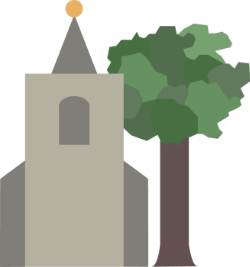At one time a distinctive and richly-coloured medieval mural painting covered the whole south wall of the nave of the church. Probably painted between 1460 and 1480, it was covered by whitewash during Cromwell’s puritan era. Uncovered in August 1858 during restoration work, it was examined by the Cambridge antiquary John Willis Clark, who published a description in The Ecclesiologist journal (volume 20, pages 316 to 321, 1859), which was reprinted in the National Trust Magazine, no. 37, pages 14-20, April 1977. This included the drawing shown below. The Rector ordered the mural to be covered again and it remained hidden until the restoration of 1986, when part of it was once more uncovered and restored (see below).
Recent research (the Seedcorn Project at Leicester University) has shown that the mural represents the Seven Deadly Sins and the Seven Corporal Works of Mercy. The mural does not photograph well as there is little contrast; here is one attempt, taken in January 2001.
At the bottom, portraying the sin of Pride, is a bearded man, with a crown on his head, a sword in his right hand, and riding on a lion. At the top, illustrating Feeding the Hungry, is a veiled woman offering loaves of bread to an invalid man with a crutch.
Hardwick is one of only two places in the country where the Deadly Sins are represented as riding on animals. The other place is Llangar church in North Wales, where the paintings have recently been restored.
The following information was provided by Dr Miriam Gill at the Hardwick Local History Day, 25 May 2002:
English church wall paintings were didactic and moralistic. They formed part of the catechism for lay people, who were required by the 4th Lateran Council to make a confession every year. M.R. James in the 1920s identified such paintings with the 7 Works of Mercy which were frequently paired with the 7 Deadly Sins (depiction of the 7 Virtues was very rare). Representation of the Sins riding on animals (as at Hardwick) came from Austria at the end of the 14th century; it is common in France but rare in England (though found in manuscripts here). The sins depicted become less serious from left to right. First the spiritual sins of Pride (the king wearing a crown riding a lion), Envy, Pride, Avarice (noblemen in high hats riding horse, deer etc) then the bodily sins Gluttony (= drinking), Lust, Sloth (workmen in low hats riding goat, donkey).
From the style of the clothes, the Hardwick painting can be dated as 1460-1480; perhaps around 1470. It would probably have been done by itinerant painters working from model books or woodcuts, and possibly paid for by a local benefactor. The original inscriptions were probably in English not Latin. Unlike the fresco technique, the paint was applied to dry plaster, so the colour layer is thin and fragile.
The painting was covered over in the 1540s with whitewash, unvcovered in a Victorian restoration and covered over again as the Victorians thought it was popish and of dubious morality. The circled cross in “Pride” is one of the church’s consecration crosses and probably predates the painting. Two similar ones have been uncovered on either side of the chancel, and the 1858 drawing shows two further ones in “Anger” and “Lust”.
For more information, see Medieval Wall Painting in the English Parish Church. Two additional images have been provided by “Doctor Digi”. These were taken in May 2002 and are copyright (c)2002 The Digital Atlas of England.
A list of the parts of the mural is given here.
On 13th August 2017, the Rev’d Dr Lynne Broughton gave a talk to members of the Cambridgeshire Historic Churches Trust on the history of the church, describing many interesting aspects of the building, including the murals. You can watch a video of the talk, including pictures of the features described, on YouTube at https://www.youtube.com/watch?v=1oQ76irJ9Bg .
The only other church in the UK with wall paintings of the Seven Deadly Sins riding on animals is at the Rug Chapel, Rug, Corwen, near Llangar Church, in Clwyd, Wales. Some more information about the Rug Chapel is given here.
